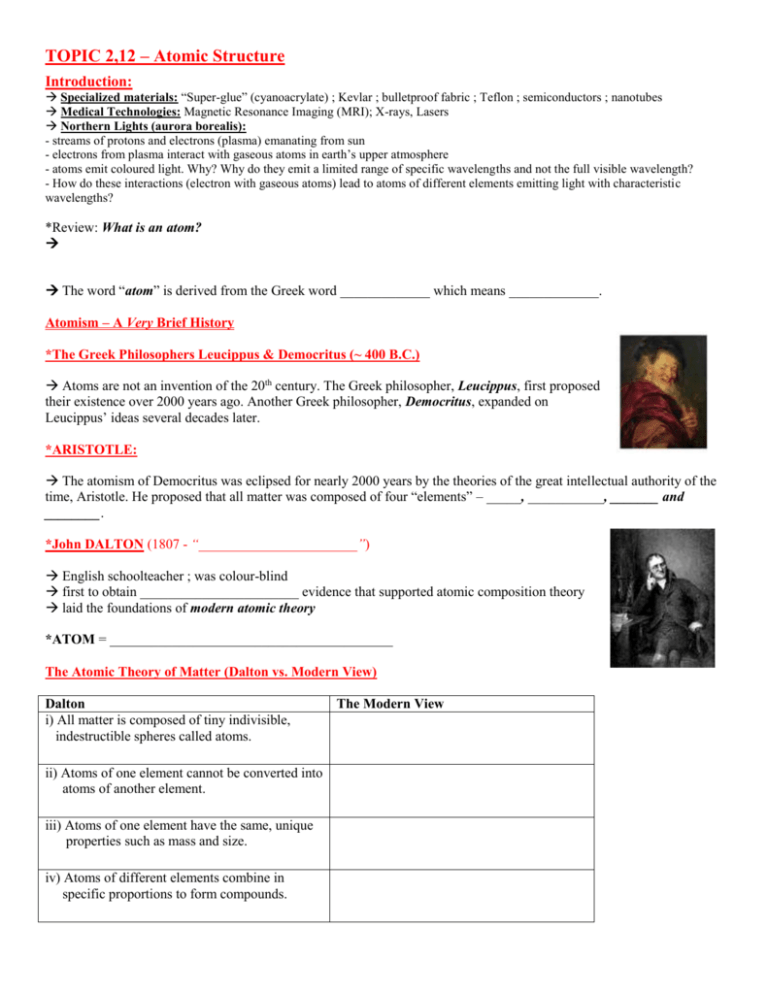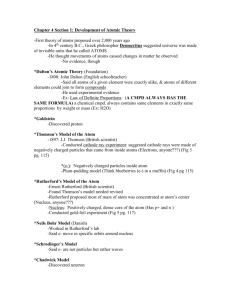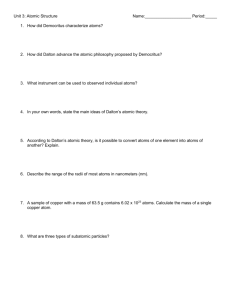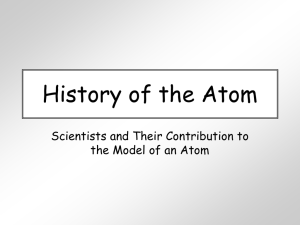Introduction and History of Atomism
advertisement

TOPIC 2,12 – Atomic Structure Introduction: Specialized materials: “Super-glue” (cyanoacrylate) ; Kevlar ; bulletproof fabric ; Teflon ; semiconductors ; nanotubes Medical Technologies: Magnetic Resonance Imaging (MRI); X-rays, Lasers Northern Lights (aurora borealis): - streams of protons and electrons (plasma) emanating from sun - electrons from plasma interact with gaseous atoms in earth’s upper atmosphere - atoms emit coloured light. Why? Why do they emit a limited range of specific wavelengths and not the full visible wavelength? - How do these interactions (electron with gaseous atoms) lead to atoms of different elements emitting light with characteristic wavelengths? *Review: What is an atom? The word “atom” is derived from the Greek word _____________ which means _____________. Atomism – A Very Brief History *The Greek Philosophers Leucippus & Democritus (~ 400 B.C.) Atoms are not an invention of the 20th century. The Greek philosopher, Leucippus, first proposed their existence over 2000 years ago. Another Greek philosopher, Democritus, expanded on Leucippus’ ideas several decades later. *ARISTOTLE: The atomism of Democritus was eclipsed for nearly 2000 years by the theories of the great intellectual authority of the time, Aristotle. He proposed that all matter was composed of four “elements” – _____, ___________, _______ and ________. *John DALTON (1807 - “_______________________”) English schoolteacher ; was colour-blind first to obtain _______________________ evidence that supported atomic composition theory laid the foundations of modern atomic theory *ATOM = _________________________________________ The Atomic Theory of Matter (Dalton vs. Modern View) Dalton i) All matter is composed of tiny indivisible, indestructible spheres called atoms. ii) Atoms of one element cannot be converted into atoms of another element. iii) Atoms of one element have the same, unique properties such as mass and size. iv) Atoms of different elements combine in specific proportions to form compounds. The Modern View *Sir J. J. THOMSON (1904 - “________________________”) Thomson won the Nobel Prize and was later knighted (a British thing…hence, the “Sir” in front of his name) for his scientific achievements. SEVEN scientists that worked under Thomson later won the Nobel prize! obtained experimental evidence that electricity is not a “subtle fluid” but consists of particles called _________________ demonstrated that electrons are universal components of all atoms *ATOM = ________________________________________________________________________ *H. BECQUEREL and Marie and P. CURIE (1896 – 1899 discovered _________________________) *What is radioactivity? Some atoms such as ____________________ and _______________naturally emit __________ (ά) positive particles and ____________ (β) negative particles and _____________(γ) radiation energy . (alpha particle = ___________ nucleus ; beta particle = ___________) *Ernest RUTHERFORD (1911 – “____________________________”) worked at Canada’s McGill University for some of his career Rutherford was one of Thomson’s distinguished seven. the first to succeed in exploring the _______________ ______________ of atoms Performed famous “________ ________ Experiment” The experimental evidence that led to the Rutherford model was the results of bombarding a thin metal foil with an ________ particle (helium nuclei) beam. The beam was mostly____________, as expected; however, a small but significant number of alpha particles were deflected – some, through very large angles. http://www.mhhe.com/physsci/chemistry/essentialchemistry/flash/ruther14.swf *ATOM: *PROBLEMS With Rutherford Model: i) Nucleus – ii) Could not explain total ___________ of the atom [discovery of the ____________ (Chadwick - 1932) helped explain mass of atom)] iii) Model proposed that electrons ________________ nucleus like planets orbit the sun. **However, ________________ charges should continuously emit _____________ ____________ ( does not happen. Electron would eventually lose energy and ___________ into the nucleus. ) – this iv) Could not explain atomic _____________. Neils BOHR…a Great Dane (1913 – “ _____ ”) worked under Rutherford combined the experimental findings of ____________ with the theoretical concepts of _________ and ______________ to develop the Bohr model of the atom successfully described the _____________ of an electron and many experimental observations in chemistry and _______________ *Max PLANCK(1900) A German theoretical physicist named Max Planck suggested that matter at the atomic level can absorb or emit only discrete, specific quantities or “packets” of energy. Each of these specific quantities is called a _____________ of energy. The energy of an atom is __________________; it is not ___________________. What does this mean? *Albert EINSTEIN (1905) light is emitted and absorbed in quantized amounts A quantum of light energy is called a __________. (a very small “packet” of EMR)








